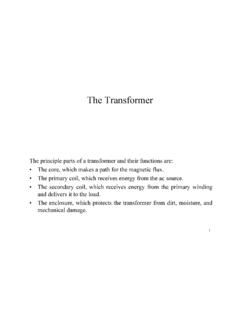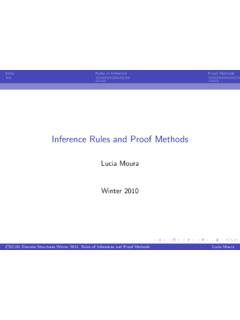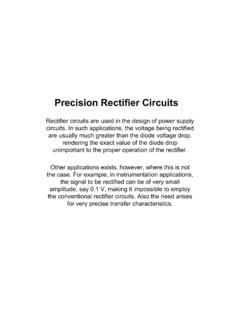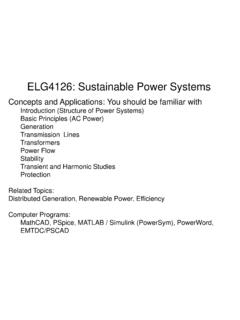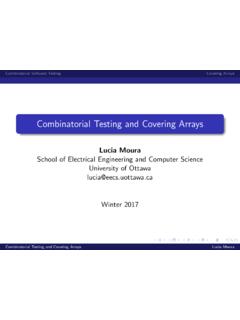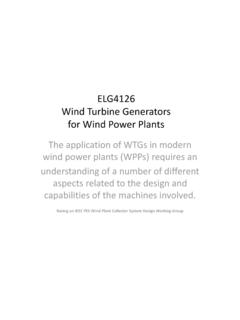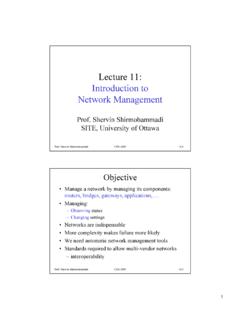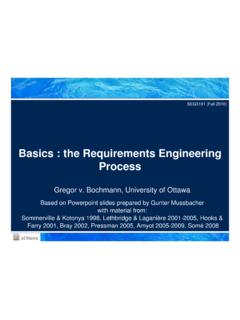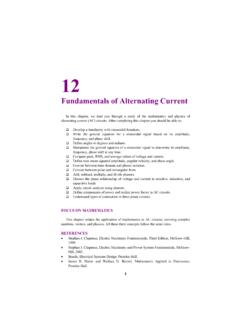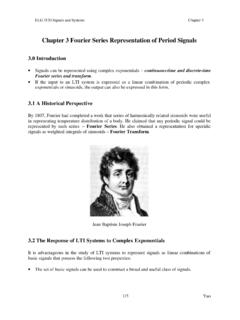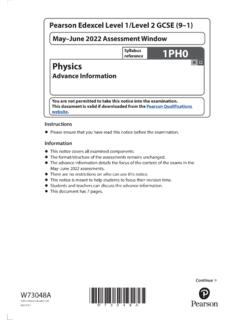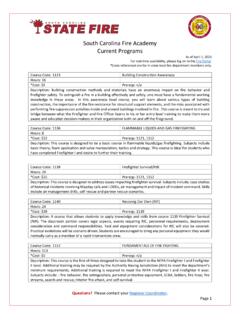Transcription of Fundamentals of Electricity - Engineering
1 1 10 Fundamentals of Electricity OBJECTIVES This chapter has been written to provide a better introduction to the fields of electric circuits and electronics. We lead you through a study of the mathematics and physics as they are jointly applied to electric circuits. After completing this chapter you should be able to Understand the physical meaning of variables used to describe Electricity . List the three major parts of an atom. Define Coulomb s law. Discuss the differences between conductors, semiconductors, and insulators. Understand the basic quantities in electric circuits such as voltage and current. Understand the characteristics of resistors, inductors, and capacitors. Define the concepts of RC and L/R time constants, which are very important in science. Understand the behavior of electric circuits using Ohm s law. Relate the three main parameters of an electric circuit: the voltage, the electric current, and the electrical resistance.
2 Realize how the above three parameters are used to compute circuit characteristics and conditions. Realize how the above parameters are used to compute electrical power. FOCUS ON MATHEMATICS This chapter relates the application of mathematics to electrical concepts, covering fractions; functions; vectors; derivatives and integration; exponential equations; and graphing techniques. 2 Chapter 10 WHAT IS Electricity ? The word Electricity originated about 600 ; it comes from elektron, which was the ancient Greek work for amber. However, the true nature of Electricity was understood later. What is Electricity ? This particular question is not easy to answer because the word Electricity has different meanings, which complement each other. Electricity may mean electric charges, flow of electric charges, or electric energy.
3 If we wish to agree on a single definition of Electricity , then which one should we choose? May be we do not need to choose just one but all of the above definitions are true. Just as coal enabled the industrial revolution, Electricity is the unseen fuel of modern life. The dramatic increase in the use of Electricity for domestic and industrial purposes proves that electrical energy plays an important part in our society. It is impossible to imagine what our lives would be like without access to this source of energy. Technologies associated with Electricity have made our lives easier. Modern society is indeed unworkable without the existence of electrical appliances. Likewise, emerging telecommunication and information services have greatly enhanced the ability of individuals and groups to communicate with each other and have facilitated the speed of information to persons and machines in both urban and rural environments.
4 Whatever the particular field of services, possession of basic knowledge forms the basis for the performance of many varied tasks which today s engineer is called on by industry and employers to do-and do well. SYSTEMS OF UNITS In order to state the value of some measurable quantity, we must give both a number (how much) and a unit (of what) (for example, 5 meters). Regarding numbers, fortunately, we all use the same number system. However, this is not true for units, and we need some efforts to familiarize ourselves with a suitable system. This could be accomplished by following a standard unit of efficient performance. A measurement of any physical quantity must be expressed as a number followed by a unit. A unit is a standard by which a dimension can be expressed numerically. The units for the fundamental dimensions are called the fundamental or base units.
5 While carrying out EM calculations, there are several systems of base units that are available. However, they may be broken into two main groups. First, the International System of Units (SI) introduced by Griorgi in 1901, including the meter-kilogram-second-ampere (MKSA) subsystem representing the four fundamental dimensions length, mass, time, and electric current, Fundamentals of Electricity 3 respectively. Second is the centimeter-gram-second (CGS) system. The units for other dimensions are called secondary, or derived units and are based on the above fundamental units. Table 10-1 The Seven Fundamental SI Units Quantity Unit Abbreviation Length meter m Mass kilogram kg Time second s Electric current ampere A Temperature Kelvin K Luminous intensity candela cd Matter mole mol Currently, most the engineers use the practical MKSA system.
6 What is known as the Gaussian system is an unrationalized CGS system, which is mixed in the sense that electric quantities are measured in electrostatic units, while magnetic quantities are measured in magnetostatic units. The CGS system is used mainly in the area of physics, where certain simplification in formulas results. The SI is the standard system used in today s scientific literature. The SI has seven base units, several derived units with special names, and many derived units with compound names. A few CGS system units are also used when appropriate. The complete SI system involves units but also other recommendations, one of which is that multiple and submultiples of the MKSA units be set in steps of 103 or 10-3. The fundamental SI units and abbreviations are listed in Table 10-1. Table 10-2 lists many of the SI derived units used in electric and electronic circuits.
7 The SI uses the decimal system to relate larger and smaller units to the basic units, and employs prefixes to signify the various powers of 10. A list of prefixes and their symbols is given in Table 10-3. These prefixes are very important in Engineering studies and are worth memorizing. Table 10-2 SI Derived Units Quantity Symbol Unit Unit Symbol Angle Radian rad Capacitance C Farad F Conductance G Siemens S Electric charge Q Coulomb C 4 Chapter 10 Electromotive force E Volt V Energy.
8 Work W Joule J Force F Newton N Frequency f Hertz Hz Inductance L Henry H Power P Watt W Resistance R Ohm Pressure p Pascal Pa Magnetic Flux Weber Wb Magnetic Induction B Tesla T Light Flux L Lumen lm Table 10-3 SI Prefixes Metric Symbol Metric Prefix Value Power of Ten T One Trillion Tera 1012 G One Billion Giga 109 M One Million Mega 106 K One Thousand Kilo 103 m One Thousandth Milli 10-3 One Millionth Micro 10-6 n One Billionth Nano 10-9 p One Trillionth Pico 10-12 MATTER AND Electricity To understand Electricity , it is important to start with the study of atoms.
9 The atom is the basic building of the universe. Electricity is made up of atom matter. Matter consists of very small particles, which together form an atom. Matter is commonly made up of mass and weight, which occupies space. This mass can become and take into form different states such as, solid, liquid, gas, or plasma. The atom also has motion and two kinds of energy types: potential energy, which is a result of its position and kinetic energy, which is the energy of motion. An element is a substance, which cannot be reduced to a simpler substance by chemical means. Examples of elements with which we use everyday are iron, gold, silver, copper, and oxygen. There are now over 100 known elements. All the different substances we know about are composed of one or more of these elements. An atom is the smallest particle of an element that retains the characteristics of that element.
10 The atoms of one element, however, differ from Fundamentals of Electricity 5 the atoms of all other elements. Figure 10-1 Principal parts of an atom. The center of the atom is called the nucleus, which is primarily made up of particles called protons and neutrons. These two particles make up most of the atoms weight and mass. Orbiting around it are electrons (like our planets orbiting around the sun) as shown in Figure 10-1. The electrons are many times smaller in mass than protons and neutrons. Protons, electrons, and neutrons are very different from each other. They have their own properties. One of these properties is called an electrical charge. A proton has what we call a positive (+) charge. The electron has a negative (-) charge.
